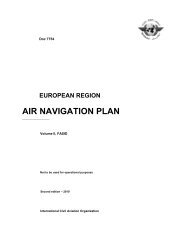7754 Vol 1 Flyleaf - ICAO Public Maps
7754 Vol 1 Flyleaf - ICAO Public Maps
7754 Vol 1 Flyleaf - ICAO Public Maps
You also want an ePaper? Increase the reach of your titles
YUMPU automatically turns print PDFs into web optimized ePapers that Google loves.
Note: - Provisions for the EUR VHF VOLMET broadcast<br />
system are detailed in FASID Part VII - ATS.<br />
9. At aerodromes with limited hours of operation, the<br />
issuance of METAR should commence at least two hours<br />
prior to the aerodrome resuming operations, or as agreed<br />
between the meteorological authority and the operators<br />
concerned, to meet pre-flight and in-flight planning<br />
requirements for flights due to arrive at the aerodrome as<br />
soon as it is opened for use.<br />
10. When required, information on the state of the<br />
runway should be included as supplementary information in<br />
all METAR and SPECI.<br />
11. States under whose jurisdiction off-shore structure<br />
or other points of significance in support of off-shore<br />
helicopter operations are located should, in consultation with<br />
the appropriate operators, establish or arrange for the establishment<br />
of aeronautical meteorological observing stations at<br />
suitable locations. Information of the state of the sea and sea<br />
surface temperature should be included in all METAR and<br />
SPECI from those stations. The offshore structures providing<br />
information on the state of the sea and/or sea surface<br />
temperature in METAR and SPECI are listed in FASID<br />
Table MET 1C.<br />
Aircraft observations and reports<br />
12 The meteorological watch offices (MWO)<br />
designated as the collecting centres for air-reports received<br />
by voice communications within the FIR/UIR for which they<br />
are responsible, are shown in FASID Table MET 1B,<br />
Column 1.<br />
FORECASTS<br />
13. Routine TAF should be issued as required in<br />
respect of operational needs for designated aerodromes as<br />
specified in FASID Table MET 1A.<br />
14. The period of validity of the routine TAF should be<br />
either 9 hours or 24 or 30 hours. The period of validity is<br />
specified in FASID Table MET 1A.<br />
15. The periods of validity for 9-hour TAF should<br />
commence at 00, 03, 06, 09, 12, 15, 18 and 21 UTC and for<br />
24 and 30-hour TAF at 00, 06, 12, 18 UTC. The periods of<br />
validity should be determined based on the types of<br />
operations (e.g. regional or inter-regional (long-haul) flights)<br />
and taking into account the hours of operation of the<br />
aerodrome as agreed between the meteorological authorities<br />
and the operators concerned.<br />
16. The scheduled international exchange of TAF<br />
should be completed<br />
� 30 minutes before commencement of the<br />
period of validity.<br />
17. The forecast maximum and minimum temperature<br />
together with their respective dates and times of occurrence<br />
should be included in the 24 and 30hour TAF for certain<br />
aerodromes as agreed between the meteorological authority<br />
and the operators concerned.<br />
18 Trend forecasts should be issued for designated<br />
aerodromes specified in FASID Table MET-1A.<br />
19 When the area forecast for low-level flights is<br />
issued as a GAMET, the following regional procedures<br />
should be followed:<br />
a) the term "widespread" should be used to<br />
indicate a spatial coverage of more than 75<br />
per cent of the area concerned;<br />
b) section II of the GAMET area forecast<br />
should include the following information<br />
in addition to the provisions in Annex 3:<br />
1) short description of general weather<br />
situation in addition to the description<br />
of pressure centres and fronts;<br />
2) information about mean surface wind<br />
speed also for values less than 60<br />
km/h (30kt);<br />
3) upper wind and temperature in<br />
mountainous areas for altitude<br />
15000ft, or higher if necessary;<br />
Note – Upper wind and temperature<br />
information should have a horizontal<br />
resolution no more than 500km;<br />
4) information about widespread surface<br />
visibility of 5000 m or more together<br />
with the weather phenomena (if any)<br />
causing a reduction of visibility and<br />
inserted between the upper wind and<br />
cloud information, and<br />
5) state of the sea and sea surface<br />
temperature;<br />
Note – States under whose<br />
jurisdiction off-shore structure or<br />
other points of significance in support<br />
of off-shore helicopter operations are<br />
located should, in consultation with<br />
the appropriate operators, establish<br />
or arrange for the information on the














